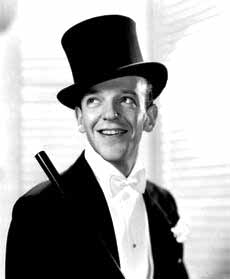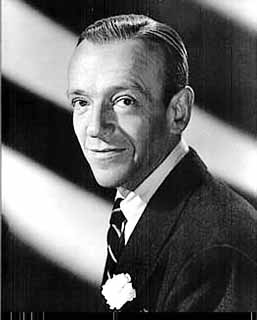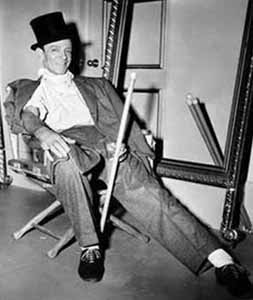
Fred Astaire
- Подробности
Fred Astaire (May 10, 1899 – June 22, 1987), born Frederick Austerlitz in Omaha, Nebraska, was an American film and Broadway stage dancer,Fred Astaire choreographer, singer and actor. His stage and subsequent film career spanned a total of seventy-six years, during which he made thirty-one musical films. He is particularly associated with Ginger Rogers, with whom he made ten films.
George Balanchine and Rudolph Nureyev rated him the greatest dancer of the twentieth century, and he is generally acknowledged to have been the most influential dancer in the history of film and television musicals. He was named the fifth Greatest Male Star of All Time by the American Film Institute.
Biography
1899-1917: Early life and vaudeville career
His father, Frederick E. Austerlitz, was an Austrian immigrant (a brewer by trade) and a Catholic; his mother Ann Gelius Austerlitz was born in the U.S. to Lutheran German parents; Astaire became an Episcopalian in 1912.
After arriving in New York City, Frederick moved to Omaha, Nebraska hoping to find work in his trade and he landed a job with the Storz Brewing Company. Shortly thereafter he met and married Ann.
Adele was their first born and she quickly revealed herself to be an instinctive dancer and singer. Early on, Ann dreamed of escaping Omaha by virtue of her children's talents. She envisioned a "brother-and-sister act", which was fairly common to vaudeville at the time. Although he refused dance lessons at first, Fred Jr. easily mimicked his sister's steps. Soon he took up the piano, the accordion, and the clarinet.
When their father became suddenly unemployed, the family moved to New York City to launch the show business career of the children. Adele and Fred Jr. had a teasing rivalry but fortunately they quickly acknowledged their individual strengths--his being durability and hers greater overall talent.
Astaire was a name taken by him and his sister in 1905, when they were taking instruction in dance, speaking, and singing in preparation for developing an act. Family legend attributes it to an uncle surnamed "L'Astaire".
Finally, their first act took shape and was called Juvenile Artists Presenting an Electric Musical Toe-Dancing Novelty. In it, Fred wore a top hat and tails in the first half and a lobster outfit in the second. The goofy act debuted in Keyport, New Jersey in a "tryout theater", and the local paper wrote, "the Astaires are the greatest child act in vaudeville."
After a short time, as a result of Fred's father's salesmanship, Fred and Adele landed a major contract and they played the famed Orpheum circuit throughout the U.S., including Omaha. Soon Adele grew to at least three inches taller than Fred and the pair began to look incongruous. The family decided to take a two-year break from show business, also to avoid trouble from the Gerry Society and the child labor laws of the time.
Their career resumed with mixed fortunes, though with increasing skill and polish, as they began to incorporate tap dancing into their routines. From Aurelia Coccia, they learned the tango, waltz, and other ballroom dances popularized by Vernon and Irene Castle.
Some sources state that the Astaire siblings appeared in a 1915 film entitled Fanchon, the Cricket, starring Mary Pickford, but the Astaires have consistently denied this.
While on the hunt for new music and dance ideas, Fred Astaire first met George Gershwin, who was working as a song plugger in Jerome H. Remick's, in 1916. Their chance meeting was to have profound consequences for the subsequent careers of both artists.
Fred was always on the lookout for new steps he spotted on the circuit and was starting to demonstrate his ceaseless quest for novelty and perfection. Finally, they broke into Broadway with Over The Top (1917), a patriotic revue.
1917-1933: Stage career - Broadway and London
They followed up with several more shows and of their work in The Passing Show of 1918, Heywood Broun wrote "In an evening in which there was an abundance of good dancing, Fred Astaire stood out...He and his partner, Adele Astaire, made the show pause early in the evening with a beautiful loose-limbed dance."
By this time, Fred's dancing skill was beginning to outshine his sister's, though she still set the tone of their act and her sparkle and humor drew much of the attention, due in part to Fred's careful preparation and strong supporting choreography.
During the 1920s, Fred and Adele appeared on Broadway and on the London stage in shows such as George and Ira Gershwin's Lady Be Good (1924) and Funny Face (1927), and later in The Band Wagon (1931), winning popular acclaim with the theater crowd on both sides of the Atlantic.
After the close of Funny Face, the Astaires went to Hollywood for a screen test (now lost) at Paramount studios but were not considered suitable for films.
They split in 1932, when Adele married her first husband, Lord Charles Cavendish, a son of the Duke of Devonshire. Astaire went on to achieve success on his own on Broadway and in London with Gay Divorce, while considering offers from Hollywood. The end of the partnership was traumatic for Astaire but stimulated him to expand his range. Free of the brother-sister constraints of the former pairing, and with a new partner Claire Luce, he created a romantic partnered dance to Cole Porter's Night and Day which had been written for Gay Divorce. This number was credited with the success of the stage play and, when recreated in the film version of the play The Gay Divorcee (1934), ushered in a new era in filmed dance.
1933-1939: Fred and Ginger at RKO
According to Hollywood folklore, an RKO Pictures screen test report on Astaire, now lost along with the test, is supposed to have read: "Can't sing. Can't act. Balding. Can dance a little." The producer of the Astaire-Rogers pictures Pandro S. Berman claimed he had never heard the story in the 1930s and that it only emerged years later. Astaire, in a 1980 interview on ABC's 20/20 with Barbara Walters, insisted that the report had actually read: "Can't act. Slightly bald. Also dances". In any case, the test was clearly disappointing, and David O. Selznick, who had signed Astaire to RKO and commissioned the test, described it as "wretched" in a 1933 studio memo. However, this did not affect RKO's plans for Astaire, first lending him for a few days to MGM in 1933 for his Hollywood debut, where he appeared as himself dancing with Joan Crawford in the successful musical film Dancing Lady.
On his return to RKO Pictures, he got fifth billing alongside Ginger Rogers in the 1933 Dolores Del Rio vehicle Flying Down to Rio. In a review, Variety magazine attributed its massive success to Astaire's presence: "The main point of Flying Down to Rio is the screen promise of Fred Astaire ... He's assuredly a bet after this one, for he's distinctly likable on the screen, the mike is kind to his voice and as a dancer he remains in a class by himself. The latter observation will be no news to the profession, which has long admitted that Astaire starts dancing where the others stop hoofing."
Although Astaire was initially very reluctant to become part of another dance team, he was persuaded by the obvious public appeal of the Astaire-Rogers pairing. That partnership, and the choreography of Astaire and Hermes Pan, helped make dancing an important element of the Hollywood film musical. Astaire and Rogers made ten films together, including The Gay Divorcee (1934), Roberta (1935), Top Hat (1935), Follow the Fleet (1936), Swing Time (1936), Shall We Dance (1937), and Carefree (1938). Six out of the nine musicals he created became the biggest moneymakers for RKO; all of the films brought a certain prestige and artistry that all studios coveted at the time. Their partnership elevated them both to stardom; as Katharine Hepburn reportedly said, "He gives her class and she gives him sex." Astaire easily received the benefits of a percentage of the film's profits, something extremely rare in actors' contracts at that time; and complete autonomy over how the dances would be presented, allowing him to revolutionize dance on film.
Astaire is credited with two important innovations in early film musicals. First, he insisted that the (almost stationary) camera film a dance routine in a single shot, if possible, while holding the dancers in full view at all times. Astaire famously quipped: "Either the camera will dance, or I will." Astaire maintained this policy from The Gay Divorcee (1934) onwards, until overruled by Francis Ford Coppola, who directed 1968's Finian's Rainbow, his first film musical. Astaire's style of dance sequences thus contrasted with the Busby Berkeley musicals, which were known for dance sequences filled with extravagant aerial shots, quick takes, and zooms on certain areas of the body, such as the arms or legs.Fred Astaire Second, Astaire was adamant that all song and dance routines be seamlessly integrated into the plotlines of the film. Instead of using dance as spectacle as Busby Berkeley did, Astaire used it to move the plot along. Typically, an Astaire picture would include a solo performance by Astaire - which he termed his "sock solo", a partnered comedy dance routine, and a partnered romantic dance routine.
Dance commentators Arlene Croce, Hannah Hyam and John Mueller consider Rogers to have been Astaire's greatest dance partner, while recognizing that some of his later partners displayed superior technical dance skills, a view shared by Hermes Pan and Stanley Donen. Film critic Pauline Kael adopts a more neutral stance, while Time magazine film critic Richard Schickel writes "The nostalgia surrounding Rogers-Astaire tends to bleach out other partners."
Mueller sums up Rogers' abilities as follows: "Rogers was outstanding among Astaire's partners not because she was superior to others as a dancer but because, as a skilled, intuitive actress, she was cagey enough to realize that acting did not stop when dancing began ... the reason so many women have fantasized about dancing with Fred Astaire is that Ginger Rogers conveyed the impression that dancing with him is the most thrilling experience imaginable." According to Astaire, "Ginger had never danced with a partner before. She faked it an awful lot. She couldn't tap and she couldn't do this and that ... but Ginger had style and talent and improved as she went along. She got so that after a while everyone else who danced with me looked wrong."
However, Astaire was still unwilling to have his career tied exclusively to any partnership, having already been linked to his sister Adele on stage. He even negotiated with RKO to strike out on his own with A Damsel in Distress in 1937, unsuccessfully as it turned out. He returned to make two more films with Rogers, Carefree (1938) and The Story of Vernon and Irene Castle (1939). When both lost money, Astaire left RKO, while Rogers remained and went on to become the studio's hottest property in the early forties. They were reunited in 1949 for their final outing, The Barkleys of Broadway.
1940-1947: Drifting to an early retirement
In 1939, Astaire left RKO to freelance and pursue new film opportunities. He teamed up with other stars, notably with Bing Crosby in Holiday Inn (1942) and later Blue Skies (1946). He was almost outdanced in Broadway Melody of 1940 (1940) by one of his first post-Rogers dance partners, Eleanor Powell. Other partners during this period included Paulette Goddard in Second Chorus (1940), Rita Hayworth in You'll Never Get Rich (1941) and You Were Never Lovelier (1942), Joan Leslie in The Sky's the Limit (1943), and Lucille Bremer in Yolanda and the Thief (1945) and Ziegfeld Follies (1946). Ziegfeld Follies also contains a memorable teaming of Astaire with Gene Kelly.
After announcing his retirement with Blue Skies in 1946, Astaire concentrated on his horse-racing interests and went on to found the Fred Astaire Dance Studios in 1947 - which he subsequently sold in 1966.
1948-1957: Productive years with MGM and second retirement
However, he soon returned to the big screen to replace the injured Gene Kelly in Easter Parade opposite Judy Garland and Ann Miller, and for a final reunion with Rogers in The Barkleys of Broadway (1949). He then went on to make more musicals throughout the 1950s: Let's Dance (1950) with Betty Hutton, Royal Wedding (1951) with Jane Powell, Three Little Words (1950) and The Belle of New York (1952) with Vera-Ellen, The Band Wagon (1953) and Silk Stockings (1957) with Cyd Charisse, Daddy Long Legs (1955) with Leslie Caron, and Funny Face (1957) with Audrey Hepburn. His legacy at this point was thirty musical films in twenty-five years. Afterwards, Astaire announced that he was retiring from dancing in film to concentrate on dramatic acting, scoring rave reviews for the nuclear war drama On the Beach (1959).
1958-1981: Branching out into televised dance and straight acting
Astaire did not retire from dancing completely. He made a series of four highly rated, Emmy-winning musical specials for television in 1958, 1959, 1960, and 1968, each featuring Barrie Chase, with whom Astaire enjoyed an Indian summer of dance creativity. The first of these programs, 1958's An Evening with Fred Astaire, won nine Emmy Awards, including "Best Single Performance by an Actor" and "Most Outstanding Single Program of the Year." It was also noteworthy for being the first major broadcast to be prerecorded on color videotape.
Astaire's last major musical film was Finian's Rainbow (1968), in which he shed his white tie and tails to play an Irish rogue who believes if he buries a crock of gold in the shadows of Fort Knox it will multiply. His dance partner was Petula Clark, who portrayed his skeptical daughter. He admitted to being as nervous about singing with her as she confessed to being apprehensive about dancing with him. But unfortunately for him, the film, directed by Francis Ford Coppola, was a box-office failure.
Astaire continued to act into the 1970s, appearing on television as the father of Robert Wagner's character of Alexander Mundy in It Takes a Thief and in films such as The Towering Inferno (1974), for which he received his only Academy Award nomination in the category of Best Supporting Actor. He voiced the mailman narrator in 1970's classic animated film, "Santa Claus is Comin' to Town. He appeared in the first two That's Entertainment! documentaries in the mid-1970s. In the second, aged seventy-six, he performed a number of song-and-dance routines with Gene Kelly -- which marked his last dance performances in a musical film. In 1976, he recorded a disco-styled rendition of Carly Simon's "Attitude Dancing." In 1978, Fred Astaire co-starred with Helen Hayes in a well-received television film, A Family Upside Down, in which they play an elderly couple coping with failing health. Astaire won an Emmy Award for his performance. He made a well-publicized guest appearance on the science fiction TV series Battlestar Galactica in 1979, as Chameleon, the maybe-father of Starbuck, in the installment "The Man With Nine Lives," a role written for him by Donald P. Bellisario after Astaire asked his agent to obtain a role for him in that series program. His final film role was the 1981 adaptation of Peter Straub's novel Ghost Story. This horror film was also the last for two of his most prominent castmates, Melvyn Douglas and Douglas Fairbanks Jr.
Dancing and singing prowess
Astaire was a virtuoso dancer, able to convey lighthearted adventuresomeness or deep emotion when called for. His technical control and sense of rhythm were astonishing; according to one anecdote, he was able, when called back to the studio to redo a dance number he had filmed several weeks earlier for a special effects number, to reproduce the routine with pinpoint accuracy, down to the last gesture. Astaire's execution of a dance routine was prized for its elegance, grace, originality and precision. He drew from a variety of influences, including tap and other African-American rhythms, classical dance and the elevated style of Vernon and Irene Castle, to create a uniquely recognizable dance style which greatly influenced the American Smooth style of ballroom dance, and set standards against which subsequent film dance musicals would be judged. He choreographed all his own routines, usually with the assistance of other choreographers, primarily Hermes Pan.
His perfectionism was legendary, as was his modesty and consideration towards his fellow artists; however, his relentless insistence on rehearsals and retakes was a burden to some. Although he viewed himself as an entertainer first and foremost, his consummate artistry won him the adulation of such twentieth century dance legends as George Balanchine, the Nicholas Brothers, Mikhail Baryshnikov, Margot Fonteyn, Bob Fosse, Gregory Hines, Gene Kelly, Rudolph Nureyev, and Bill Robinson.
Extremely modest about his singing abilities — he frequently claimed that he couldn't sing — Astaire introduced some of the most celebrated songs from the Great American Songbook, in particular, Cole Porter's: "Night and Day" in Gay Divorce (1932); Irving Berlin's "Isn't This a Lovely Day?", "Cheek to Cheek" and "Top Hat, White Tie and Tails" in Top Hat (1935), "Let's Face the Music and Dance" in Follow the Fleet (1936) and "Change Partners" in Carefree (1938). He first presented Jerome Kern's "The Way You Look Tonight" in Swing Time (1936); the Gershwins' "They Can't Take That Away From Me" in Shall We Dance (1937), "A Foggy Day" and "Nice Work if You Can Get it" in A Damsel in Distress (1937); Johnny Mercer's "One for My Baby" from The Sky's the Limit (1943) and "Something's Gotta Give" from Daddy Long Legs (1955); and Harry Warren and Arthur Freed's "This Heart of Mine" from Ziegfeld Follies (1946).
Astaire also co-introduced a number of song classics via song duets with his partners. For example, with his sister Adele, he co-introduced the Gershwins' "I'll Build a Stairway to Paradise" from Stop Flirting (1923), "Fascinating Rhythm" in Lady, Be Good (1924), "Funny Face" in Funny Face (1927); and, in duets with Ginger Rogers, he presented Irving Berlin's "I'm Putting All My Eggs In One Basket" in Follow the Fleet (1936), Jerome Kern's "Pick Yourself Up" and "A Fine Romance" in Swing Time (1936), along with The Gershwins' "Let's Call The Whole Thing Off" from Shall We Dance (1937). With Judy Garland, he sang Irving Berlin's "A Couple of Swells" from Easter Parade (1948); and, with Jack Buchanan, Oscar Levant, and Nanette Fabray he delivered Betty Comden and Adolph Green's "That's Entertainment" from The Band Wagon (1953).
Although he possessed a light voice, he was admired for his lyricism, diction and phrasing - the grace and elegance so prized in his dancing seemed to be reflected in his singing, a capacity for synthesis which led Burton Lane to describe him as "The world's greatest musical performer." Irving Berlin considered Astaire the equal of any male interpreter of his songs - "as good as Jolson, Crosby or Sinatra, not necessarily because of his voice, but for his conception of projecting a song". Jerome Kern considered him the supreme male interpreter of his songs and Cole Porter and Johnny Mercer also admired his unique treatment of their work. And while George Gershwin was somewhat critical of Astaire's singing abilities, he wrote many of his most memorable songs for him. In his heyday, Astaire was referenced in lyrics of songwriters Cole Porter, Larry Hart and Eric Maschwitz and continues to inspire modern songwriters.
Astaire was a songwriter of note himself, with "I'm Building Up To An Awful Letdown" - written with lyricist Johnny Mercer - reaching number 4 in the Hit Parade of 1936. He recorded his own "It's Just Like Taking Candy from a Baby" with Benny Goodman in 1941, and nurtured a lifelong ambition to be a successful popular song composer.
Main menu
Anthology
Sheet Music Archive
 lesson 1lesson 2lesson 3
lesson 1lesson 2lesson 3

